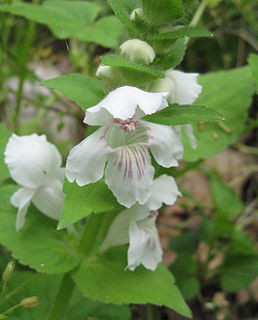
Symplocos is a genus of flowering plants in the order Ericales. It contains about 300 species distributed in Asia and the Americas. Many species grow in humid tropical regions. This is sometimes considered to be the only genus in family Symplocaceae. Plants in this family are shrubs and trees with white or yellow flowers.

The perennial vine Lonicera hispidula is a species of honeysuckle known as pink honeysuckle and, less often, California honeysuckle. It is a low-elevation woodlands shrub or vine found on the West Coast of the United States.
Symplocos anamallayana is a species of plant in the family Symplocaceae. It is endemic to India.
Symplocos bractealis is a species of plant in the family Symplocaceae. It is endemic to Sri Lanka.
Symplocos canescens is a species of plant in the family Symplocaceae. It is endemic to Ecuador. Its natural habitat is subtropical or tropical moist montane forest.
Symplocos cordifolia is a species of plant in the family Symplocaceae. It is endemic to Sri Lanka.
Symplocos costata is a species of plant in the family Symplocaceae. It is endemic to Sumatra. It is a vulnerable species threatened by habitat loss.
Symplocos fuscata is a species of plant in the family Symplocaceae. It is endemic to Ecuador. Its natural habitat is subtropical or tropical moist montane forest.
Symplocos molinae is a species of plant in the family Symplocaceae. It is endemic to Honduras.
Symplocos octopetala is a species of evergreen woody plant with small white flowers in the family Symplocaceae. It is endemic to Jamaica. First described in 1788, the most recent concept of the species includes three taxa described as separate species in the late 19th and early 20th century.
Symplocos oligandra is a species of plant in the family Symplocaceae. It is endemic to India. It is threatened by habitat loss.
Symplocos peruviana is a species of plant in the family Symplocaceae. It is endemic to Peru.
Symplocos truncata is a species of plant in the family Symplocaceae. It is endemic to Ecuador. Its natural habitat is subtropical or tropical moist montane forest.

Symplocaceae is a family of flowering plants in the order Ericales, including two genera, Symplocos and Cordyloblaste, totalling about 260 known species. The common name for Symplocaceae is sweetleaf. Symplocaceae has a transpacific distribution that covers the Southeast United States, South America, Southeast Asia and Northern Australia. Plants in the family Symplocaceae are generally trees or shrubs, and are found in humid, tropical, montane forests within their range.

Symplocos tinctoria is a deciduous or evergreen shrub or tree. It is recognized by pith of twigs chambered; by foliage not notably aromatic when bruised, leaves finely hairy beneath. Shrubs or trees to 17 m tall by 36 cm DBH. The largest first-year twigs are under 3 mm across, terminal buds with acute tip, scales ciliate. Leaves are 7–15 cm long, margin entire or occasionally some teeth on the apical half, with a sweet taste that may be faint in old leaves. It is conspicuous when in flower; flowers opening before new leaves develop, fragrant, in clusters from axils of previous year's leaves or from just above the leaf scars if the leaves have fallen; the petals are creamy yellow to yellow, with one pistil. Fruits nearly cylindrical to ellipsoid drupes 8–12 mm long, with thin pulp and a hard stone containing 1 seed; the tip usually retaining parts of the sepals. Foliage is relished by browsing wildlife. A yellow dye may be obtained from bark and leaves. It flowers Mar to May.

Ocinebrina edwardsii is a species of sea snail, a marine gastropod mollusk in the family Muricidae, the murex snails or rock snails.
Alvania hispidula is a species of minute sea snail, a marine gastropod mollusk or micromollusk in the family Rissoidae.

Gaultheria hispidula, commonly known as the creeping snowberry or moxie-plum, is a perennial spreading ground-level vine of the heath family Ericaceae native to North America that produces small white edible berries. It fruits from August to September. Its leaves and berries taste and smell like wintergreen.

Synandra is a monotypic genus of flowering plants in the mint family containing the single species Synandra hispidula, which is known by the common name Guyandotte beauty. It is native to the east-central United States where it ranges from southern Illinois to western North Carolina and Virginia.

Acacia hispidula, known colloquially as little harsh acacia, rough-leaved acacia or rough hairy wattle, is a species of Acacia native to eastern Australia.







